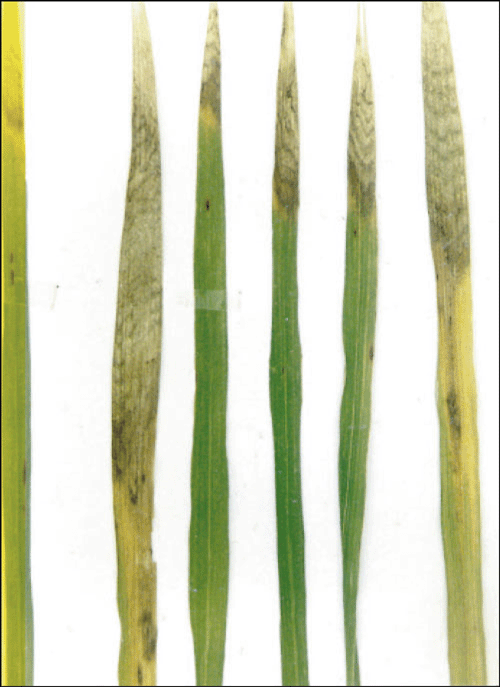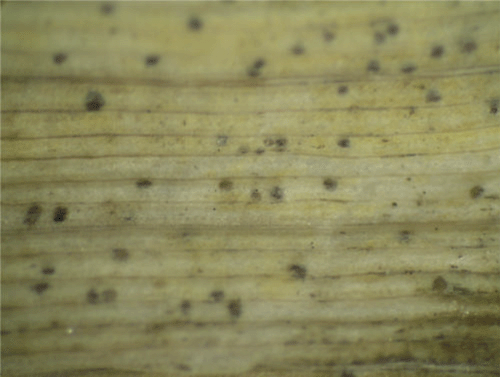First record of Monographella albescens on rice in Corrientes Province, Argentina
S. A. Gutiérrez A D , E. M. Reis B and M. A. Carmona CA Cátedra de Fitopatología, Facultad de Ciencias Agrarias, Universidad Nacional del Nordeste, Sargento Cabral 2131 (3400), Corrientes, Argentina.
B Fitopatología, Facultade de Agronomia e Veterinaria, UPF, Cx. Postal 611, 99001-970, Passo Fundo, Brasil.
C Fitopatología, Facultad de Agronomia, Universidad de Buenos Aires, Av. San Martín 4453 (1417), Ciudad de Buenos Aires, Argentina.
D Corresponding author. Email: suarroz@yahoo.com.ar
Australasian Plant Disease Notes 2(1) 19-20 https://doi.org/10.1071/DN07008
Submitted: 6 November 2006 Accepted: 19 January 2007 Published: 1 February 2007
Abstract
Monographella albescens (teleomorph) is recorded for the first time on leaves of rice in Corrientes Province, Argentina.
Rice (Oryza sativa) is an important crop in Corrientes Province, Argentina. Leaf scald of rice is a disease of increasing importance in rice crops (Mazzanti de Castañón and Gutiérrez 2001). The disease is characterised by zonate lesions with alternating light tan to dark brown bands that dry out giving leaves and foliar sheaths a scalded appearance (Fig. 1). The disease is caused by the fungus Monographella albescens (Thüm.) V.O. Parkinson, Sivan. & C. Booth (synonym Metasphaeria albescens Thüm.) which is usually detected in infected tissue in its anamorphic stage, Microdochium oryzae (Hashioka and Yokogi) Samuels & I.C. Hallet (synonyms Gerlachia oryzae (Hashioka and Yokogi) W. Gams and Rhynchosporium oryzae Hashioka and Yokogi). In the two rice crops grown during 2004–06 in Corrientes Province, the sexual stage of the fungus, Monographella albescens, was detected.

|
Leaves with leaf scald symptoms were colleted from rice field crops in the localities of Itá Ibaté, Mercedes, Santo Tomé and Virasoro (Corrientes Province, Argentina). The infected samples were from the rice varieties Taim, CT 6919, IRGA 417, Supremo 1 and Supremo 13. The specimens were incubated in a moist chamber and infected pieces of leaves were plated onto potato-glucose agar (PGA) and bean agar. Morphometric and cultural features of the causal agent were studied. The isolates were placed in the fungal collection of the Laboratory of Plant Pathology, Faculty of Agronomy, University of North East-Corrientes Province, Argentina.
Perithecia of M. albescens were found in the green and senescent leaves of rice crops close to ripening. In the diseased tissues, the fungus develops light brown subepidermal perithecia, which become dark brown when mature (Fig. 2). The perithecia were globose, compressed, dark brown and measuring 137.5–167.5 × 87.5–120 µm; asci were cylindrical, hyaline and tapered at both ends, with eight yellowish hyaline, slightly curved oblong ascospores with three to four septate, measuring 12.5–20 × 3–3.7 µm (Fig. 3). The morphological features agree with those given by other authors (Ou et al.1978; Boratynski 1979; Parkinson et al. 1981).

|

|
After 10 days on PGA, the fungus developed a whitish cotton-like colony with creamy-like salmon-pink masses corresponding to the conidial stage M. oryzae. The perithecia did not mature.
Leaf scald disease of rice occurs worldwide; it has been reported in Africa, Asia and the USA. In Latin America it can be found in Costa Rica, El Salvador, Guatemala, Brazil and Argentina (Boratynski 1979; Webster and Gunnell 1992; Mazzanti de Castañón and Gutiérrez 2001). Rice seed is the major source of inoculum (Webster and Gunnell 1992). In Costa Rica, the teleomorph is also considered an important source of inoculum as well as contaminated seeds and crop stubble (Boratynski 1979).
In Argentina, Microdochium oryzae is the most frequent stage seen in field crops. The symptoms are often seen in leaves close to the soil towards the end of the tillering stage. Symptoms continue to develop until the panicle emerges, which is when the fungus infects the rice grain (Mazzanti de Castañón and Gutiérrez 2001; Gutiérrez 2002). The teleomorph is detected only in the senescent leaves or the leaves that are still green in the ripening stages of the crop. This is the first report of Monographella albescens in Argentina. The role that Monographella albescens plays in the epidemiology of rice scald in Argentina is not known. The sexual stage may provide another source of dissemination of the pathogen and to generate fungal variability. Is important to evaluate the potential role of seed borne Microdochium oryzae as primary inoculum for field epidemics, and to evaluate fungicide seed treatments.
Boratynski TN
(1979) La escaldadura de la hoja de arroz Rhynchosporium oryzae Hashioka e Ikegami, en Costa Rica. Agronomia Costarricense 3, 21–27.

Mazzanti de Castañón MA, Gutiérrez SA
(2001) Enfermedades del cultivo del arroz en Argentina. Fitopatologia Brasileira [supplement] 26, 471.

Ou H,
Nuque FL, Vergel de Dios TI
(1978) Perfect stage of Rhynchosporium oryzae and the symptoms of leaf scald disease. Plant Disease Reporter 62, 524–528.

Parkinson VO,
Sivanesan A, Booth C
(1981) The perfect state of the rice leaf scald fungus and the taxonomy of both the perfect and imperfect states. Transactions of the British Mycological Society 76, 59–69.



